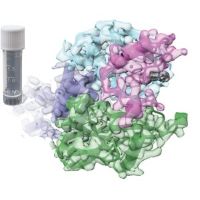Specification
| Organism | Homo sapiens (Human) |
| Expression Host | E.coli |
| Tag Info | Tag-Free |
| Purity | Greater than 95% as determined by SDS-PAGE. |
| Uniprot ID | P20783 |
| Uniprot Entry Name | |
| Gene Names | NTF3 |
| Alternative Names | Neurotrophin-3; NT-3; HDNF; Nerve Growth Factor 2; NGF-2; Neurotrophic Factor; NTF3 |
| Expression Region | Full Length of Mature Protein (139-257aa) |
| Molecular Weight | 13.6 kDa |
| Endotoxin | Less than 1.0 EU/µg as determined by LAL method. |
| Sequence | YAEHKSHRGEYSVCDSESLWVTDKSSAIDIRGHQVTVLGEIKTGNSPVKQYFYETRCKEARPVKNGCRGIDDKHWNSQCKTSQTYVRALTSENNKLVGWRWIRIDTSCVCALSRKIGRT |
| Product Form | Lyophilized powder (Lyophilized from a 0.2 μm filtered 20 mM PB, 250 mM NaCl, pH 7.2) |
| Reconstitution | Please reconstitute protein in deionized sterile water and we recommend that briefly centrifuge thevial prior to opening the vial .We recommend aliquot for long-term storage at -20℃/-80℃. |
Background
| Relevance | Neurotrophin-3 (NT-3) is a member of the NGF family of neurotrophic factors and is structurally related to β-NGF, BDNF and NT-4. The NT3 cDNA encodes a 257 amino acid residue precursor protein with a signal peptide and a proprotein that are cleaved to yield the 119 amino acid residue mature NT3.The amino acid sequences of mature human, murine and rat NT-3 are identical. NT-3 selectively promotes the differentiation and survival of specific neuronal subpopulations in both the central as well as the peripheral nervous systems. |
| Function | Seems to promote the survival of visceral and proprioceptive sensory neurons. |
| Involvement in disease | |
| Subcellular Location | Secreted |
| Protein Families | NGF-beta family |
| Tissue Specificity | Brain and peripheral tissues. |
| Pathway | MAPKsignalingpathway |
QC Data
| Note | Please contact us for QC Data |
| Product Image (Reference Only) |  |

